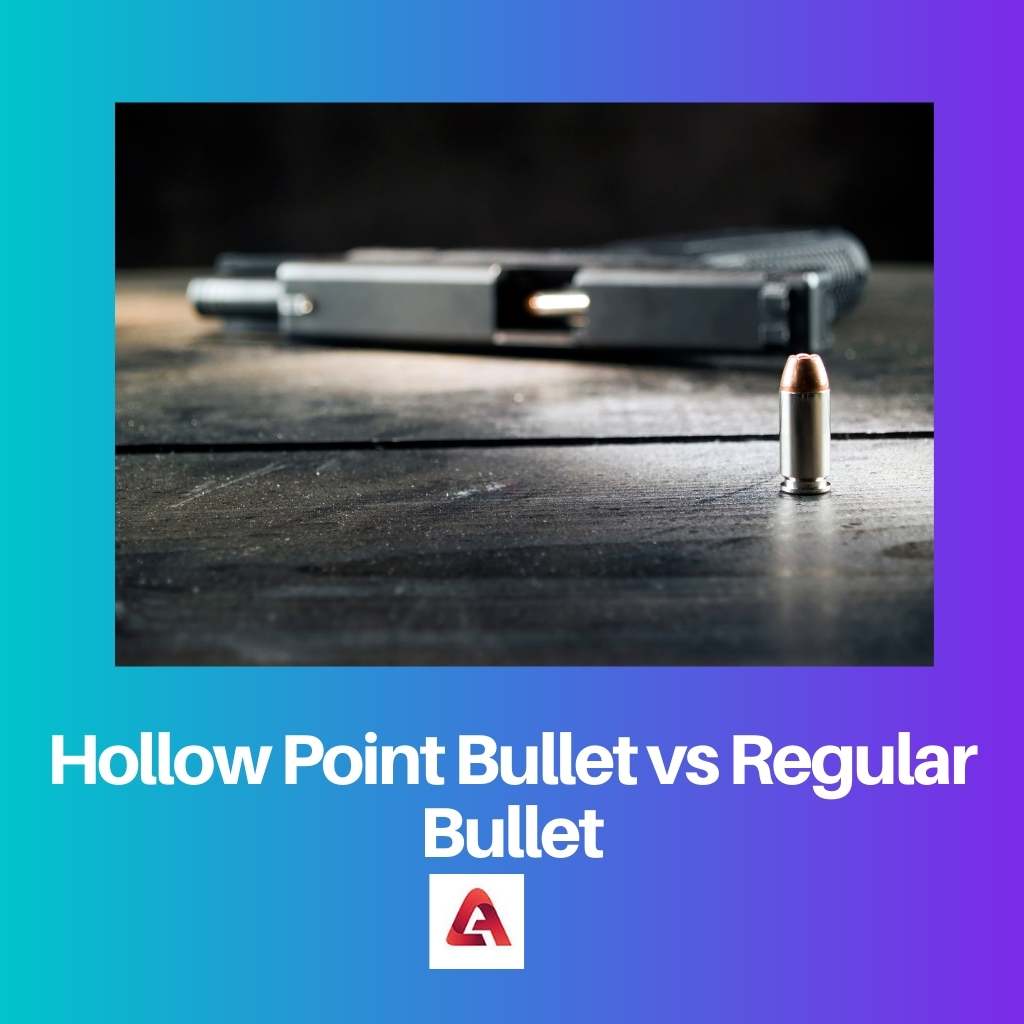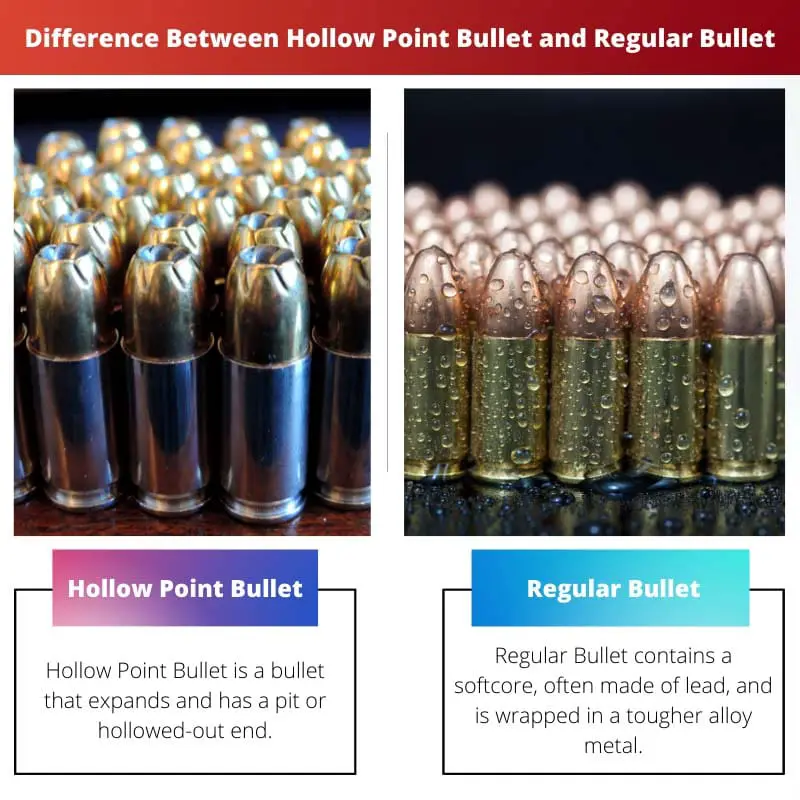Few individuals comprehend the significance of utilizing the proper ammo in various conditions. Some bullets are meant for target practice, while others are intended to do as much destruction as possible.
Hollowpoint and regular bullets are the two most commonly mentioned kinds of ammunition. It’s equally crucial to have the correct ammo so that you can use your pistol as efficiently as possible.
Key Takeaways
- Hollow point bullets have a hollowed-out cavity in the tip, designed to expand upon impact, maximizing damage to the target.
- Regular bullets, or full metal jacket bullets, have a solid metal casing and do not expand upon impact, resulting in less damage to the target.
- Hollow-point bullets are used for self-defense and hunting, while regular bullets are commonly used for target practice and military applications.
Hollow Point Bullet vs Regular Bullet
A hollow point bullet has a hollowed-out area at the tip of the projectile, designed to cause the bullet to expand upon impact, creating a larger wound channel and causing more tissue damage. A regular bullet has a solid lead core with a copper or brass jacket that covers the entire projectile.

Hollow Point Bullet is a bullet that expands and has a pit or hollowed-out end. Since they explode on contact, these bullets are favored by shooters and in self-defense situations.
When hollow-point bullets strike a subject, the hollow tip causes the bullet to distort (looking more like a mushroom), delaying the bullet and providing additional stopping force.
Regular Bullet contains a softcore, made of lead, and is wrapped in a tougher alloy metal, such as cupronickel or gilding metal.
These rounds’ goal is to maintain their trajectory, and they have better penetration against soft tissue. These rounds are suitable for aim practice because they do not extend when they reach their target.
Comparison Table
| Parameters of Comparison | Hollow Point Bullet | Regular Bullet |
|---|---|---|
| Build | They have a cavity in the middle. | They are solid. |
| Mechanism | They are meant to expand | They don’t expand. |
| Damage | They do more damage. | They do less damage. |
| Accuracy | More accurate and predictable | Less accurate |
| Speed | 1,000 feet per second | 600 to 5000 feet per second. |
What is a Hollow Point Bullet?
A hollow-point bullet is an inflatable round intended for controlled puncture in instances when over-penetration might cause indiscriminate injury. They are used to raise specificity in aim shooting significantly.
Hollow-point bullets are far more credible and stable than pointed ones, which are more susceptible to bullet harmonics features and air deflection while having a greater ballistic coefficient (BC).
This bullet spreads on contact, resulting in a more devastating strike while without entering any deeper than recommended.
The hollow-point bullet fabrication process also produces a flat, evenly formed underside on the round, which supposedly enhances steadiness by providing a more consistent piston surface for the cartridge’s inflation chemicals.
All hollow point and smooth soft-nosed bullets are alluded to as dum-dums, just after the colonial armory at Dum Dum, which is currently located in north Calcutta, India, where crimped, expanding bullets are thought to have originally been manufactured.
Hollowpoint bullets feature a concave core coated with lead or a comparable substance.
Gentle point bullets bridge the gap between a full metal jacket and hollow point ammo. Both hollow and soft point bullets are engineered to swell upon contact while fracturing inside the target.
These bullets are designed to halt and neutralize a subject in a single shot.

What is a Regular Bullet?
The tips of standard bullets are flat or rounded and made of soft metal. This is frequently referred to as a full metal jacket. These bullets have a proclivity to puncture a target, providing a clean opening and open wound.
These bullets are regarded to be more beneficial when attempting to injure someone or practicing target shooting.
The major reason such bullets injure rather than kill is that they really do not do a lot of internal injuries. They have the ability to puncture the body and important organs, yet they seldom dissolve or fracture after impact.
As a result, someone may have a bullet pass through their heart and still survive for up to 30 seconds before passing out.
Pointed bullets (as seen in rifle bullets) are angled to reduce resistance as the bullet travels through the air. Lower air resistance implies that the bullet is delayed less by friction, allowing it to maintain greater velocity for a longer period of time.
The sooner the bullet reaches the victim, the less time it has to react to elements that impact accuracy (gravity, wind, etc.).
Furthermore, the faster a bullet strikes a target (depending on velocity and bullet stability), the more destruction it may inflict on it.
Regular bullets, especially ones traveling at high speeds, have a tendency to pass through targets.
When the target is hidden behind something weak, such as wood or very few layers of thin metal, a normal bullet is much more likely to penetrate through the barriers and strike the object with plenty of force to be successful.

Main Differences Between Hollow Point Bullet and Regular Bullet
- Hollow-point bullets have a cavity in the middle meanwhile, regular bullets are solid
- Hollow-point bullets are engineered to expand meanwhile, regular bullets are not designed to expand.
- Hollow-point bullets have a higher damage capacity, whereas conventional bullets have a lower damage capacity.
- Hollow point bullet is more exact and reliable, but regular bullets are comparatively less accurate
- Hollow point bullets travel at 1,000 feet per second, whereas conventional bullets go between 600 to 5000 feet per second.

- https://heinonline.org/hol-cgi-bin/get_pdf.cgi?handle=hein.journals/milrv206§ion=6
- https://www.sciencedirect.com/science/article/pii/S0379073818304201

I think this article does a great job at explaining the complex nature of bullet types in a clear and concise manner.
I had no idea about the intricacies of bullet types until I read this article. It was both fascinating and educational.
This article is a great resource for anyone looking to understand the critical differences between hollow point and regular bullets.
I second that, Nathan.
This article is extremely informative, the comparison table is a very helpful way to show the difference between the two types of bullets.
I completely agree with you, Preid.
The level of detail you went into is very much appreciated, this article is as thorough as it gets.
Although I already had a basic understanding of bullet types, this article gave me an even deeper insight into the topic. A very well-informed piece of work.